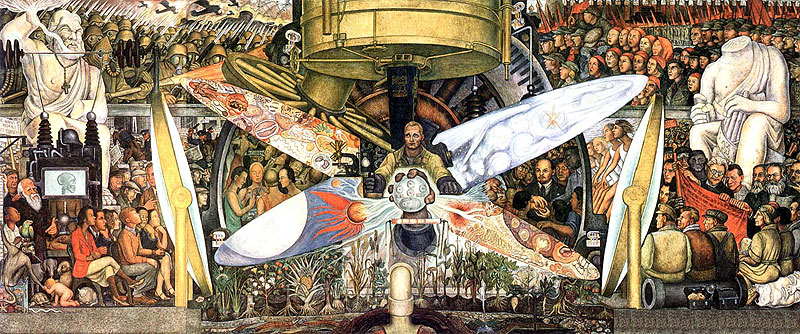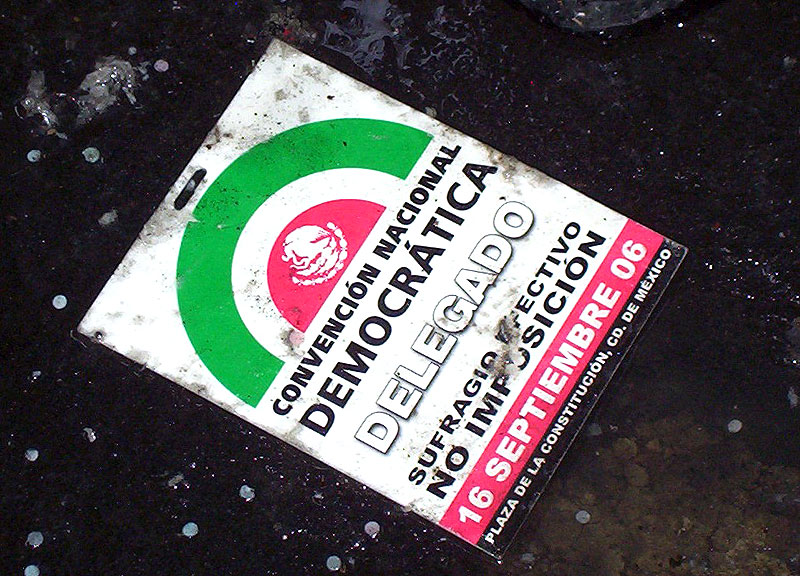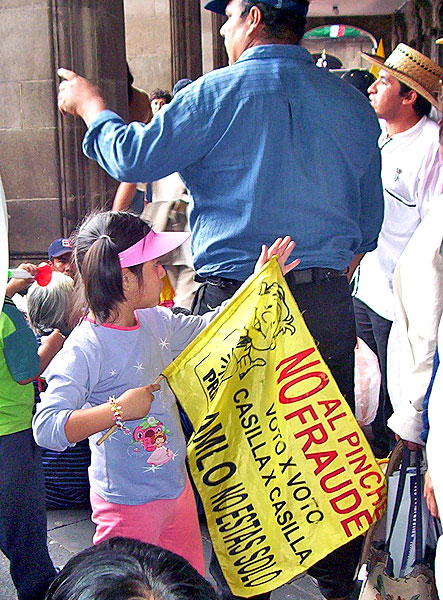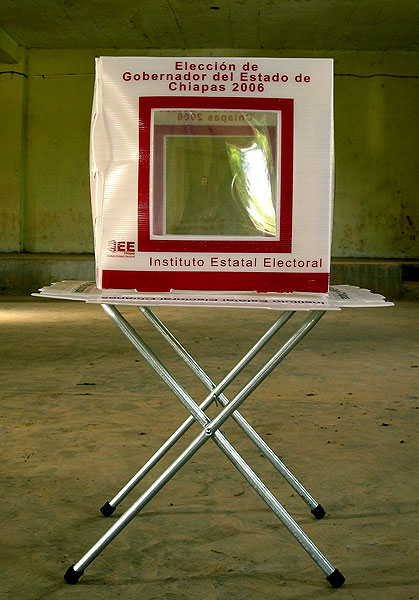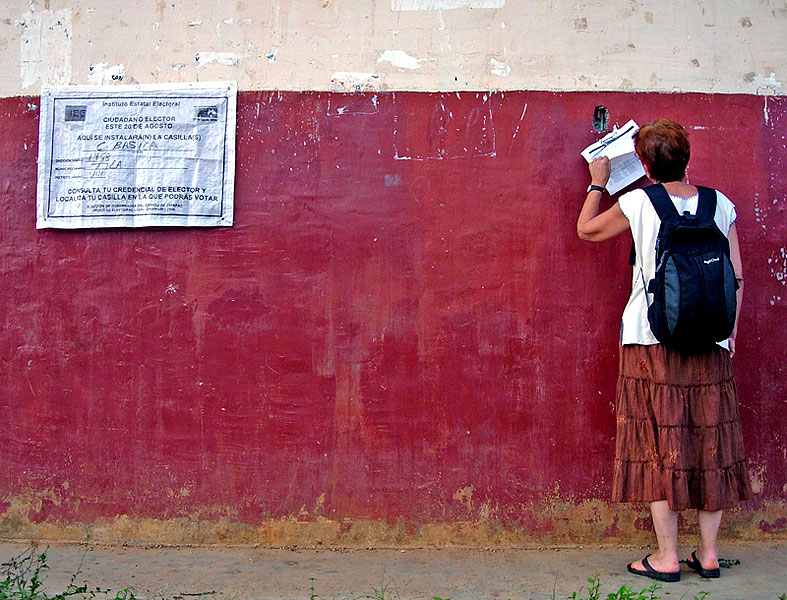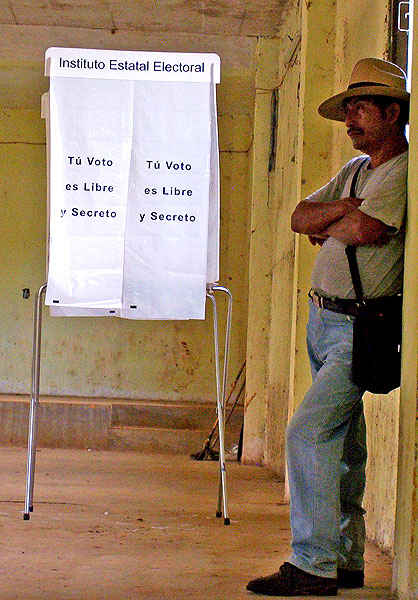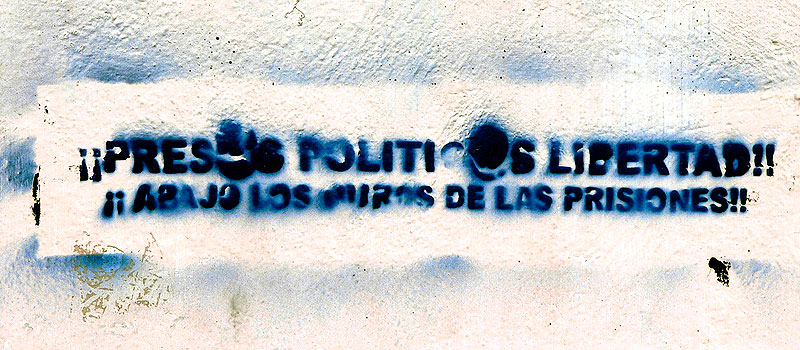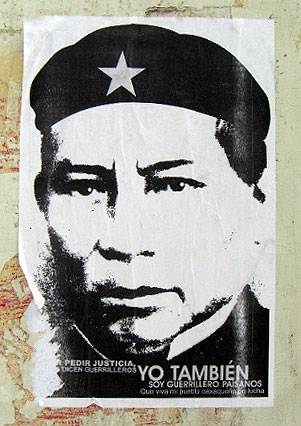SIPAZ Activities (April – June 2006)
31/07/20062006
01/01/2007The longest elections in the history of Mexico
On 2 July, Mexico went through federal elections, the results of which were severely questioned (the difference between the two principal candidates was less than 1%). La Coalición por el Bien de Todos, the Coalition for the Benefit of All, (which integrates various leftist parties: the Party of the Democratic Revolution, PRD; the Labor Party, PT, and the Convergence Party, Convergencia) legally impugned these elections by presenting a total of 225 appeals at the Federal Electoral Tribunal of Judicial Power (TEPJF) corresponding to more than 52,000 ballot boxes.
Andrés Manuel López Obrador (AMLO, the candidate for the presidency for the Benefit of All), and his followers were demanding the opening of all the electoral boxes and the counting of the ballots “vote by vote”. This was the principal slogan of the massive mobilizations that were conducted principally in Mexico City throughout the month of July before taking shape in the “Permanent Assembly”, which established a sit-in and blockades in the most important avenues of the capital until mid September.
During 36 days there was a tense wait for the decisions by the TEPJF. The result was a rejection of a total re-count of the votes and instead it ordered the opening of 9% of the electoral boxes (about 12,000 ballot boxes from 146 districts). The re-count was carried out between the 9 and 27 August. When the tendency of the TEPJF pointed towards the ratification of the triumph of Felipe Calderón (the candidate of the Party of National Action, PAN, conservative party currently in power), AMLO prioritized more and more the political way over the legal.
On 13 August, invoking article 39 of the Constitution (popular sovereignty), AMLO called on a National Democratic Convention (CND) for 16 September, the day of commemoration of the National Independency. CND proposed to elect a legitimate president and to work out 5 actions of transformation for the country: the struggle against poverty and inequality; to impede the privatization of natural and energy resources; to defend the right to information; to combat corruption and to reform the public institutions.
On 20 August, the TEPJF rejected the majority of the impugnations as “legally inadmissible”. The re-count of 9% of the ballot boxes reduced Calderón’s advantage over AMLO only by 4,183 votes.
Throughout the month of August, PAN and Felipe Calderón maintained a relatively low profile, carrying out reunions with governors, congress-people from the Institutional Revolutionary Party (PRI) and the business-sectors. They made public calls for “national unity” and for the creation of “a government of coalition” which however raised little echo, which has to be viewed as a result of the political and social polarization that was generated during the electoral process.
A date of high political tension during the period of waiting for the TEPJF decisions was 1 September, the day when President Fox was to present his last report to the government. During the last two weeks before the event, a high level of militarization was observed around the area surrounding the Legislative Palace, where it was supposed to take place. On 15 August, sympathizers and members of the Coalition for the Benefit of All attempted to install a sit-in at the gates of the Congress and were driven away. Some media reported about the existence of “groups of deterrence” that were trained in military bases to be put into selective actions of repression against the leaders of the civil resistance.
On 1 September, the Legislative Palace was sieged by the military that accounted for a presence of 8,000 elements of the Preventive Federal Police (PFP) and the Presidential General Staff supported by tanks and snipers. Rejecting the military presence, PRD and PT congress-people occupied the Tribune. President Fox eventually decided to hand over his report in writing in the vestibule of the Legislative Palace. Only moments afterwards, a message by President Fox that had been recorded earlier was broadcasted on national television in which there was no hesitance in the attacks against AMLO and the movement supporting him.
Finally, on 5 September, the TEPJF unanimously declared Felipe Calderón as elected president and rejected all the denunciations presented by the Coalition for the Benefit of All. This rejection included those appeals alleging Fox’s interference in favor of Calderón as well as the illegal broadcast of messages, paid for by entrepreneurial sector, which impacted negatively on AMLO’s campaign. The Tribunal, while acknowledged both instances, established however that “there was no way of determining the electoral impact – if there ever was one – from both actions”. Calderón immediately made a new call for “dialogue and unity” while AMLO declared that “they were not recognizing an Executive lacking legitimacy”.
The political tension did not diminish. During the first fortnight of September, Fox and Calderón saw themselves repeatedly harassed by AMLO sympathizers. Calderón, almost secretly collected his constancy as president at the TEPJF.
On 15 September, Fox decided to move the ceremony of the commemoration of the Mexican Independency to Dolores Hidalgo, Guanajuato, with high security measures. In Mexico City, the event was led by Alejandro Encinas in his capacity as Chief of Government of the Federal District, and with the presence of the Secretary of Government, Carlos Abascal. As to the military parade 16 September, AMLO determined to clear the main avenues in Mexico City of the camps of resistance that were blocking these streets, and to spread the agenda of the CND foreseen for the same day in order to give passage to the military. In both cases, they were able to avoid a direct confrontation.
The CND was realized in presence of more than one million delegates from all over the country. They proclaimed AMLO as the legitimate president and passed a Plan of 6 actions: not to accept Calderón; to empower AMLO with the right to take over the presidency on 20 November; to authorize him to form his cabinet; to undertake short-term actions of resistance and to prevent the taking over of power by Felipe Calderón on 1 December; to sustain the CND with periodical meetings and to integrate three commissions of coordination (regarding “National Politics”, “Civil Resistance” and “Organization of the Plebiscite and the Constituent”).
The CND provoked various critics, including from the left, in particular corresponding the fact that the process was mainly led by members of political parties (instead of members by Civil Committees of support) and by polemical personalities, of whom various had previously been linked to the much criticized ex-President Carlos Salinas (PRI, 1988-1994).
The Coalition for the Benefit of All was transformed into the Progressive Front (FAP), which was registered as the same at the Federal Electoral Institute (IFE). On 17 September, AMLO moved to Tabasco with the aim to support the campaign of the candidate of the Coalition for governor. Nevertheless, according to the preliminary results (October) PRI had won the elections.
Elections for governor in Chiapas: inverted parallelism
The federal electoral impugnations were still not resolved when on 20 August elections for governor were carried out in Chiapas. Multiple irregularities were denounced: the practice of purchase, manipulation and coercion of votes; the direct interference of the governor still in power (Pablo Salazar Mendiguchía), including in the selection of the candidates; electoral usage of social programs by the government of the state in order to favor the candidate Juan Sabines (candidate of the Coalition for the Benefit of All), among many.
The state governmental support in favor of Sabines provoked the other 4 contestants for governor to make a joint denunciation that they were having to confront an election by the State. Just shortly before the elections, PAN, the New Alliance Party (PANAL) and the Alternative Social-democratic Party invited their followers to vote for PRI, to thereby avoid a victory for Sabines. They were out of time though to register themselves as a political alliance, which obstructed the accumulation of their votes in the counting.
Even though there was no information of major incidents during the day of elections, there was a high level of abstentions which reached almost 56%. This can be explained by various factors: historically the level of abstentions in Chiapas is one of the highest in the country, since 1995 the Zapatista bases of support have decided not to participate in any elections, and finally, the nomination of the candidates for these elections evoked discontent and confusion amongst the bases of rural and indigenous organizations. For example, until April 2006, Sabines served as the town president for PRI in Tuxtla Gutiérrez.
The results and reactions subsequent to the elections admit the observation of an inverted parallelism compared to the presidential struggle, once again with a minimal difference between the two prime candidates. Sabines immediately proclaimed himself as the elected governor; the state PRD opposed the opening of the voting boxes and the re-counting of the votes.
By presenting the following final results the State Electoral Institute (IEE) declared Sabines the winner:
| POLITICAL PARTY OR COALITION | VOTES | PERCENTAGE |
| COALITION FOR THE BENEFIT OF ALL (PRD/PT/CONVERGENCIA) | 553,27 | 46.97% |
| ALIANCE FOR CHIAPAS (PRI/PVEM) | 546,988 | 46.44% |
| PAN | 29,476 | 2.50% |
| PANAL | 3,492 | 0.29% |
| PASDYC | 6,395 | 0.54% |
| VOID VOTES | 36,57 | 3.10% |
| CITIZEN PARTICIPATION | 1,177,710 | 45.37% |
He therefore won by a very slim margin (0,55%) by votes in his favor that only represent a fifth part of the total electorate. The Alliance for Chiapas (PRI and PVEM) and its allies, PANAL and PAN, objected to his triumph by presenting 391 challenges to the State Electoral Tribunal (TEE).
The TEE ratified Sabines’ triumph with similar arguments to those displayed by the TEPJF in the case of the presidential elections. Pressure against state magistrates was reported by Pablo Salazar. PRI impugned the TEE resolution at the TEPJF. On 27 October, the TEPJF ratified Sabines’ victory.
Meanwhile, Sabines had distanced himself publicly from the post-electoral mobilizations worked out by AMLO. The office of “transition” of Felipe Calderón on its hand declared its recognition of Sabines’ triumph and declared that “if PRI decides to impugn the elections at the state and federal tribunals, they will respect their decisions, but the National Alliance will not support that”.
Chiapas: Electoral, historical and new conflicts
The electoral use of public resources was observed especially in the region that was affected by the hurricane Stan last year (the coastal and mountain regions). Before the state elections the accumulated resources and the reconstruction work were set loose and were accompanied by an intensive campaign of official broadcasting linking resources and work to the possible victory of Sabines. This campaign ceased immediately when the electoral process ended. The Federal Secretary of Social Development denounced the electoral use of the resources by the state government, questioning the public management of official numbers, for instance of the advances and the results.
In September, mobilizations and denunciations of official non-fulfillment and interruption of construction once again emerged by the victims of the hurricane Stan. What also may have had a weight in some cases is the incidence by José Antonio Aguilar Bodegas, the PRI candidate for governor, who was originally from the region.
The state elections also revived wounds and fears. In communities that were victimized by the paramilitary groups particularly between 1995 and 2000, there was exercised a “vote of fear” in favor of PRD, induced by the rumor that if PRI would win, the paramilitary groups would be re-activated.
In the Highlands, old conflicts were once again sharpened (religious, by the arbitrary imposition of traditions and customs, natural resources) which were made even more complex by inter-party disputes (PRI-PRD). In various regions, the mobilization against the high electricity tariffs was maintained.
In the northern Zone, a violent police operation was carried out to expel 30 Zapatista families in the community of the Ch’oles, autonomous municipality El Trabajo (Tumbalá) that were accused of having deprived the owner of his private property.
In September, the offices of the Human Rights Centre Fray Bartolomé de las Casas were broken into. It represents the 18th case of intimidation and threat against human rights defenders in Chiapas in the course of this year, all of them still being with impunity.
The Other Campaign repositioning itself
In September, after several months of low political and media profile, the Zapatista Army of National Liberation (EZLN) announced the reset of national tour of Delegate Zero (sub-commander Marcos) . It had been suspended after the repression in Atenco in May. It has as its aim to between 8 October and 30 November to visit the 11 states still not covered in the tour before May. The support to the Popular Front in Defense of the Land (FPDT) in Atenco was maintained. Since 29 September, 3 Zapatista commanders are staying in Mexico City.
During this month, an extensive communiqué in 5 parts called “The Zapatistas and the Other Campaign: the pedestrians of the history” was diffused. The first part is a historical recovery of what made them break with the political class, about the Sixth Declaration from the Lacandona Jungle (June 2005) and the initiative to construct something new, from below and to the left.
An analysis follows on the political situation in the country in which the criticism against the PRD, AMLO and against what he calls the “supposed left” is explained. It heavily criticizes the fact that the people that are leading the CND and who are in the inner circle around AMLO were high-ranking officials during the period of president Salinas. It questions whether AMLO’s project was as neo-liberal as the one of Calderón, but that it was “administrating the crisis and controlling the social discontent”. It recognizes the legality and the good intentions of those that mobilized themselves against the fraud and in favor of AMLO. However, it affirms “this is not our track“. It expresses their support for Oaxaca (in various documents, subcomandante Marcos has explained that they will not offer a more direct support in order not to cause the APPO accusations of having links with armed groups) and justifies the rebellion of indigenous peoples, young people, sexual and maquila workers, women and leftist anti-capitalist organizations.
The new agenda proposed includes the realization of a new consultation about 6 points to define the Other Campaign: characteristics, structure, alliance politics, differences, those convoked and not, common tasks. This consultation will be carried out from October 2006 till February 2007.
On the other hand, the EZLN announced the realization of the second Inter-galactic Encounter against neo-liberalism and in favor of Humanity which will take place in the caracol of Oventik, Chiapas from 30 December 2006 to 2 January 2007. In order to facilitate their preparation, the “Caracoles” (Zapatista centers that correspond in their regional level to their autonomous construction) were re-opened, even though the red alert was not lifted for the insurgents.

